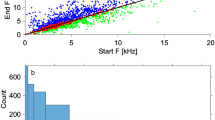Abstract.
The functional and ecological consequences of the directional emission of sounds used for communication remain largely unexplored even though non-uniform radiation patterns have been reported across a wide range of taxa. In this study the spectral structure of stereotyped calls recorded from groups of travelling killer whales (Orcinus orca) moving consistently toward or away from a towed hydrophone array was measured by comparing the energy in high-frequency (>5 kHz) with that in low-frequency (1–5 kHz) bands. Relative energy in high-frequency bands was significantly greater when animals were moving toward the hydrophone array, but only in call types that contain a separately modulated high-frequency component. The difference in relative energy as a function of direction of movement was more than 10 dB at the fundamental frequency of the high-frequency component of the two most common types recorded, confirming a strong pattern of mixed-directionality in these calls. Changes in call spectra due to signaler orientation to a receiver may provide an intrinsic cue of a moving signaler's direction of movement. Killer whales have sensitive hearing over the frequency range of this potential cue, and their marked behavioral synchrony suggests its use. The direction of movement cue inherent in the directionality pattern of calls may be an efficient and reliable means for this and possibly other highly mobile species to coordinate behavior and regulate spacing relative to other individuals.
Similar content being viewed by others
Author information
Authors and Affiliations
Additional information
Electronic Publication
Rights and permissions
About this article
Cite this article
Miller, P.J. Mixed-directionality of killer whale stereotyped calls: a direction of movement cue?. Behav Ecol Sociobiol 52, 262–270 (2002). https://doi.org/10.1007/s00265-002-0508-9
Received:
Revised:
Accepted:
Issue Date:
DOI: https://doi.org/10.1007/s00265-002-0508-9




